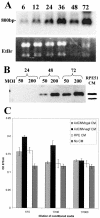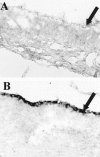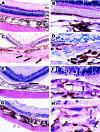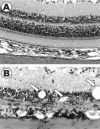Overexpression of vascular endothelial growth factor (VEGF) in the retinal pigment epithelium leads to the development of choroidal neovascularization
- PMID: 10880384
- PMCID: PMC1850220
- DOI: 10.1016/S0002-9440(10)64525-7
Overexpression of vascular endothelial growth factor (VEGF) in the retinal pigment epithelium leads to the development of choroidal neovascularization
Erratum in
- Am J Pathol 2000 Oct;157(4):1413
Abstract
Vascular endothelial growth factor (VEGF) has been strongly implicated in the development of choroidal neovascularization found in age-related macular degeneration. Normally expressed in low levels, this study investigates whether the overexpression of VEGF in the retinal pigment epithelium is sufficient to cause choroidal neovascularization in the rat retina. A recombinant adenovirus vector expressing the rat VEGF(164) cDNA (AdCMV.VEGF) was constructed and injected into the subretinal space. The development of neovascularization was followed by fluorescein angiography, which indicates microvascular hyperpermeability of existing and/or newly forming blood vessels, and histology. VEGF mRNA was found to be overexpressed by retinal pigment epithelial cells and resulted in leaky blood vessels at 10 days postinjection, which was maintained for up to 31 days postinjection. By 80 days postinjection, new blood vessels had originated from the choriocapillaris, grown through the Bruch's membrane to the subretinal space, and disrupted the retinal pigment epithelium. This ultimately led to the formation of choroidal neovascular membranes and the death of overlying photoreceptor cells. By controlling the amount of virus delivered to the subretinal space, we were able to influence the severity and extent of the resulting choroidal neovascularization. These results show that even temporary overexpression of VEGF in retinal pigment epithelial cells is sufficient to induce choroidal neovascularization in the rat eye.
Figures





References
-
- D’Amato RJ, Adamis AP: Angiogenesis inhibition in age-related macular degeneration. Ophthalmology 1995, 102:1261-1262 - PubMed
-
- Young RW: Pathophysiology of age-related macular degeneration. Surv Ophthalmol 1987, 31:291-306 - PubMed
-
- Amin R, Puklin JE, Frank RN: Growth factor localization in choroidal neovascular membranes of age-related macular degeneration. Invest Ophthalmol Vis Sci 1994, 35:3178-3188 - PubMed
-
- Frank RN: Growth factors in age-related macular degeneration: pathogenic and therapeutic implications. Ophthalmic Res 1997, 29:341-353 - PubMed
Publication types
MeSH terms
Substances
LinkOut - more resources
Full Text Sources
Other Literature Sources

